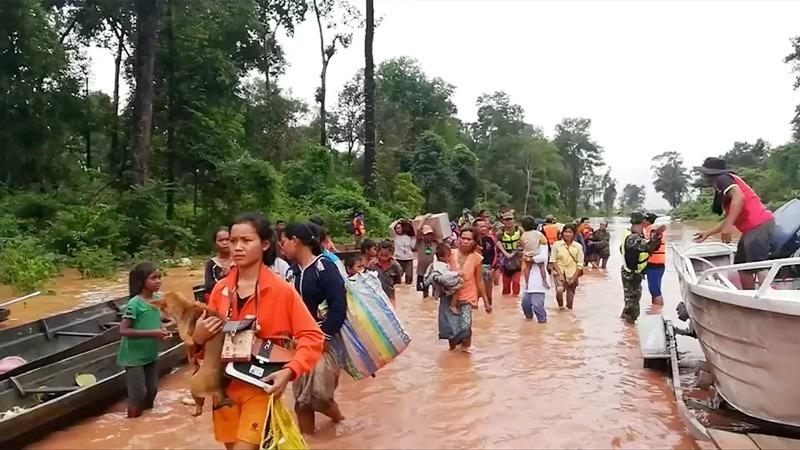Thousands stranded after dam collapses in Laos
People walk through flooded area after being brought to safety by boat in Sanam Xay district, Attapeu Province, Laos after a hydropower dam under construction in Southern Laos collapsed.
Rescue teams from China and Thailand headed on Wednesday into a remote part of landlocked Laos, where more than 3,000 people were stranded after a dam collapse sent a deluge of water across a swath of villages, domestic media said.
The Vientiane Times, citing district Governor Bounhom Phommasane, said about 19 people had been “found dead.” While nearly 3,000 had been plucked to safety, more than that number were awaiting rescue, many on the rooftops of submerged homes.
A senior Lao government official told Reuters by telephone from the capital, Vientiane, that dozens were feared dead after Monday’s failure of the dam, a subsidiary structure under construction as part of a hydroelectric project.
“We will continue with rescue efforts today, but it’s very difficult, the conditions are very difficult. Dozens of people are dead. It could be higher,” said the official, who declined to be identified as he was not authorized to speak to the media.
A United Nations report on the disaster put the death toll at five, with 34 missing, 1,494 evacuated and 11,777 people in 357 villages affected. It said 20 houses were destroyed and more than 223 houses and 14 bridges damaged by the flooding.
However, a government official said hundreds were reported missing after at least seven villages were submerged in the Attapeu province, the southernmost part of the country.
State media showed pictures of villagers, some with young children, stranded on roofs of submerged houses, and others trying to board wooden boats.
Remote location
Experts said the remoteness of the affected area could hamper relief operations.
“The roads are very poor,” Ian Baird, a professor of geography at the University of Wisconsin-Madison and a Laos expert, told Reuters by telephone.
“People don’t usually go in that area during the rainy season. There are mountains nearby that villagers might be able to get up on … I don’t think anybody really knows for sure.”
State media said a joint team of Lao and Chinese rescuers would reach Attapeu on Wednesday afternoon, and it showed a long line of cars with boats on trailers heading into the country from northeast Thailand. South Korea and Singapore have also offered to help in the rescue effort.
Laos, one of the world’s few remaining communist states and one of Asia’s poorest countries, has ambitions to become the “battery of Asia” through the construction of multiple dams.
Its government depends almost entirely on outside developers to build the dams under commercial concessions that involve the export of electricity to more developed neighbors, including power-hungry Thailand.
Rights groups have repeatedly warned against the human and environmental cost of the dam drive, including damage to the already fragile ecosystem of the region’s rivers.
Attapeu is a largely agricultural province that borders Vietnam to the east and Cambodia to the south.
The dam that collapsed was part of the $1.2 billion Xe-Pian Xe-Namnoy power project, which involves Laotian, Thai and South Korean firms. Known as “Saddle Dam D,” it was part of a network of two main dams and five subsidiary dams.
Monsoon rains
The project’s main partner, South Korea’s SK Engineering & Construction, said part of a small supply dam was washed away and the company was cooperating with the Laos government to help rescue villagers.
The firm blamed the collapse on heavy rain.
Laos and its neighbors are in the middle of the monsoon season that brings tropical storms and heavy rain. Lao state media also posted images of flash flooding, with buildings and roads under water, further north in Khammouane province.
An official at SK Engineering & Construction said fractures were discovered on the dam on Sunday and the company ordered the evacuation of 12 villages as soon the danger became clear.
Laos expert Baird said the collapse of the subsidiary dam was unlikely to affect others in the project.
“The water’s all out of the reservoir now and the water levels are already going down but I don’t think they’ll be able to fix it until the dry season,” he said.
